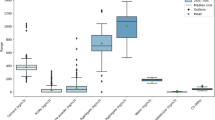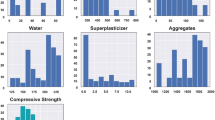Abstract
Waste glass forms a significant part of the solid waste stream globally. Since its consumption for manufacturing new glass is limited, it is mostly landfilled, which is not a sustainable mode of disposal and results in various environmental issues. Over the years, powder-grade waste glass has been used as a partial replacement for cement to produce eco-friendly concrete. This study aims to predict the compressive strength of waste glass concrete produced with 10, 20, and 25% wt.% replacement of cement with powder waste glass by employing Artificial Intelligence (AI). Specifically, the Stack (ensemble) machine learning approach, which combines multiple methods, including Adaptive Boosting (AdaBoost), Support Vector Machine (SVM), Extreme Gradient Boosting (XGBoost), and Decision Tree (DT), has been used to predict the 28 days compressive strength of concrete produced with various percentages of powder waste glass as partial replacement of cement. Comparison of the predicted compressive strengths with the laboratory test values shows that the employed machine learning (ML) models accurately predict the compressive strength of concrete mixtures that closely match the laboratory tested values. A comparison of the ML models’ statistical performance data shows Stack’s superior performance compared to other models.
Access this chapter
Tax calculation will be finalised at checkout
Purchases are for personal use only
Similar content being viewed by others
References
Nassar, R.-U.-D., Soroushian, P., Sufyan-Ud-Din, M.: Long-term field performance of concrete produced with powder waste glass as partial replacement of cement. Case Stud. Constr. Mater. 15, e00745 (2021)
Omran, A., Tagnit-Hamou, A.: Performance of glass-powder concrete in field applications. Constr. Build. Mater. 109, 84–95 (2016)
Su, Q., Xu, J.: Mechanical properties of concrete containing glass sand and rice husk ash. Constr. Build. Mater. 393, 132053 (2023)
Nassar, R.-U.-D., Soroushian, P.: Strength and durability of recycled aggregate concrete containing milled glass as partial replacement for cement. Constr. Build. Mater. 29, 368–377 (2012)
Pachideh, G., Gholhaki, M.: Effect of pozzolanic materials on mechanical properties and water absorption of autoclaved aerated concrete. J. Build. Eng. 26, 100856 (2019)
Khongpermgoson, P., et al.: The mechanical properties and heat development behavior of high strength concrete containing high fineness coal bottom ash as a pozzolanic binder. Constr. Build. Mater. 253, 119239 (2020)
Baikerikar, A., Mudalgi, S., Ram, V.V.: Utilization of waste glass powder and waste glass sand in the production of Eco-Friendly concrete. Constr. Build. Mater. 377, 131078 (2023)
Ahmed, K.S., Rana, L.R.: Fresh and hardened properties of concrete containing recycled waste glass: a review. J. Build. Eng. 70, 106327 (2023)
Abendeh, R.M., et al.: Concrete containing recycled waste glass: strength and resistance to freeze–thaw action. Proc. Inst. Civil Eng. Constr. Mater. 174(2), 75–87 (2021)
Nassar, R.-U.-D., Soroushian, P.: Green and durable mortar produced with milled waste glass. Mag. Concr. Res. 64(7), 605–615 (2012)
Jacoby, M.: Why glass recycling in the US is broken in Chemical and Engineering News (2019)
Feng, D.-C., et al.: Machine learning-based compressive strength prediction for concrete: an adaptive boosting approach. Constr. Build. Mater. 230, 117000 (2020)
Chakraborty, D., Awolusi, I., Gutierrez, L.: An explainable machine learning model to predict and elucidate the compressive behavior of high-performance concrete. Results Eng. 11, 100245 (2021)
Amlashi, A.T., et al.: Soft computing based formulations for slump, compressive strength, and elastic modulus of bentonite plastic concrete. J. Clean. Prod. 230, 1197–1216 (2019)
El-Mir, A., et al.: Machine learning prediction of concrete compressive strength using rebound hammer test. J. Build. Eng. 64, 105538 (2023)
Asteris, P.G., et al.: Predicting concrete compressive strength using hybrid ensembling of surrogate machine learning models. Cem. Concr. Res. 145, 106449 (2021)
Song, H., et al.: Analyzing the compressive strength of ceramic waste-based concrete using experiment and artificial neural network (ANN) approach. Materials 14(16), 4518 (2021)
Hilloulin, B., Tran, V.Q.: Using machine learning techniques for predicting autogenous shrinkage of concrete incorporating superabsorbent polymers and supplementary cementitious materials. J. Build. Eng. 49, 104086 (2022)
Mahmud, M., et al.: Deep learning in mining biological data. Cogn. Comput. 13(1), 1–33 (2021)
Mahmud, M., et al.: Applications of deep learning and reinforcement learning to biological data. IEEE Trans. Neural Netw. Learn. Syst. 29(6), 2063–2079 (2018)
Adiba, F.I., Islam, T., Kaiser, M.S., Mahmoud, M., Rahman, M. A.: Effect of corpora on classification of fake news using NaiveBayes classifier. Int. J. Autom. Artif. Intell. Mach. Learn. 1(1), 80–92 (2020)
Yang, J., et al.: Experimental investigation and AI prediction modelling of ceramic waste powder concrete – an approach towards sustainable construction. J. Market. Res. 23, 3676–3696 (2023)
Chang, Q., et al.: Data-driven based estimation of waste-derived ceramic concrete from experimental results with its environmental assessment. J. Market. Res. 24, 6348–6368 (2023)
Farooq, F., et al.: Predictive modeling for sustainable high-performance concrete from industrial wastes: a comparison and optimization of models using ensemble learners. J. Clean. Prod. 292, 126032 (2021)
Author information
Authors and Affiliations
Corresponding author
Editor information
Editors and Affiliations
Rights and permissions
Copyright information
© 2024 The Author(s), under exclusive license to Springer Nature Singapore Pte Ltd.
About this paper
Cite this paper
Nassar, RUD., Sohaib, O. (2024). Prediction of the Compressive Strength of Sustainable Concrete Produced with Powder Glass Using Standalone and Stack Machine Learning Methods. In: Nguyen, N.T., et al. Recent Challenges in Intelligent Information and Database Systems. ACIIDS 2024. Communications in Computer and Information Science, vol 2145. Springer, Singapore. https://doi.org/10.1007/978-981-97-5934-7_13
Download citation
DOI: https://doi.org/10.1007/978-981-97-5934-7_13
Published:
Publisher Name: Springer, Singapore
Print ISBN: 978-981-97-5933-0
Online ISBN: 978-981-97-5934-7
eBook Packages: Computer ScienceComputer Science (R0)




